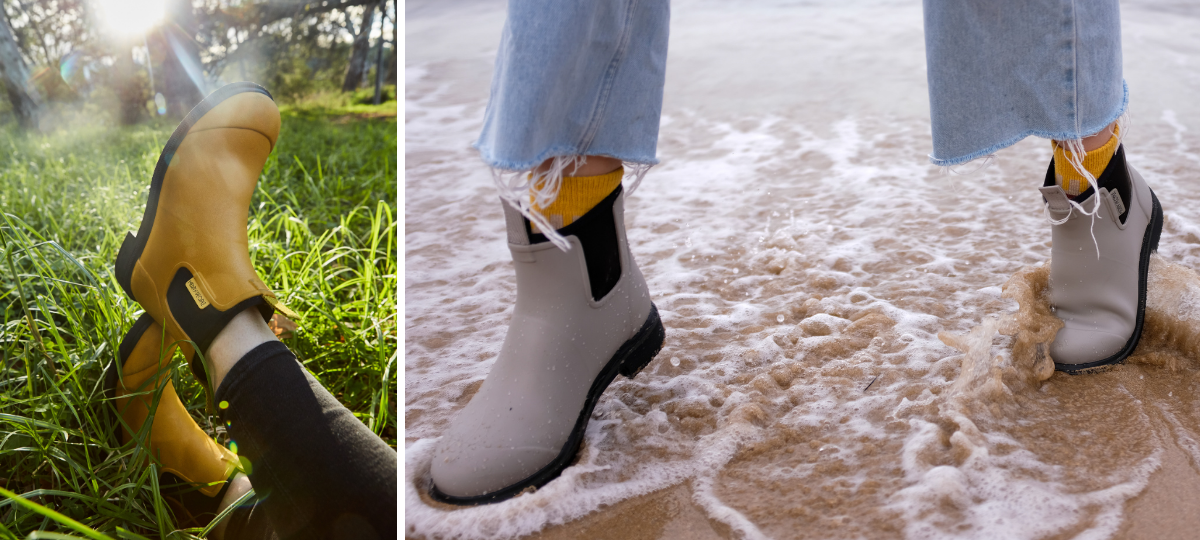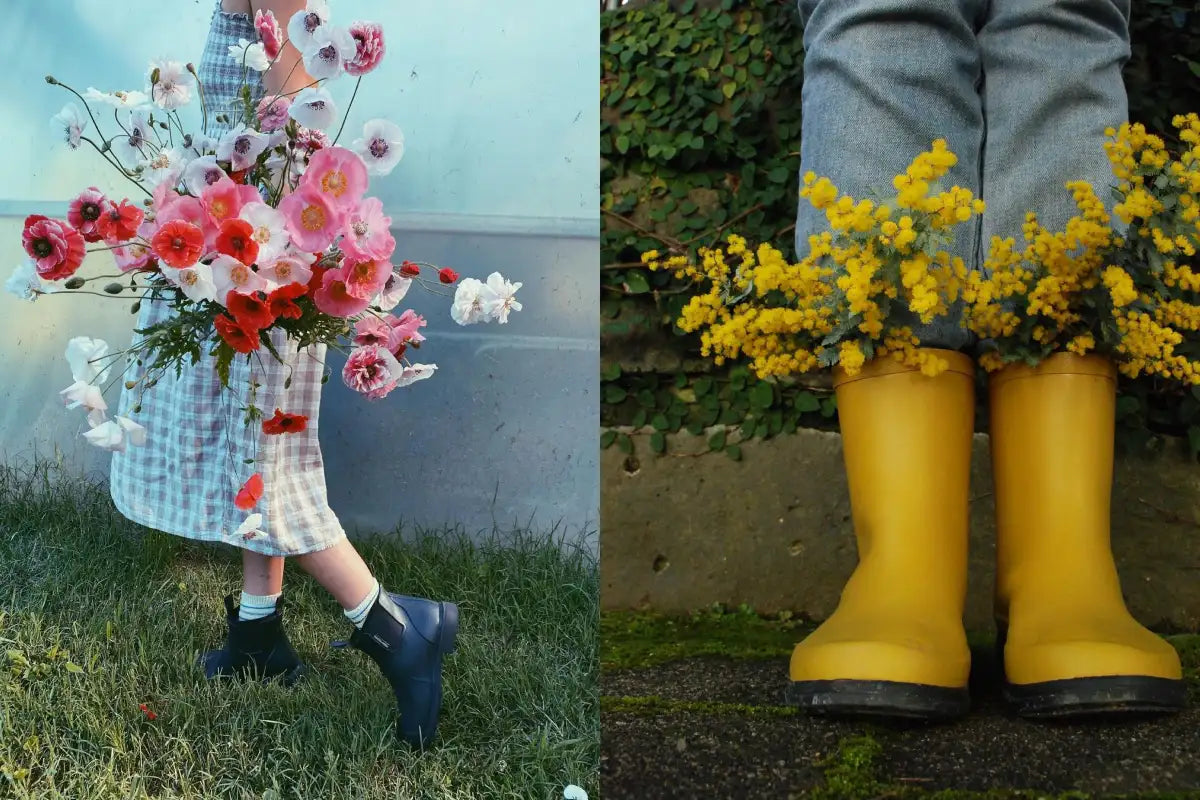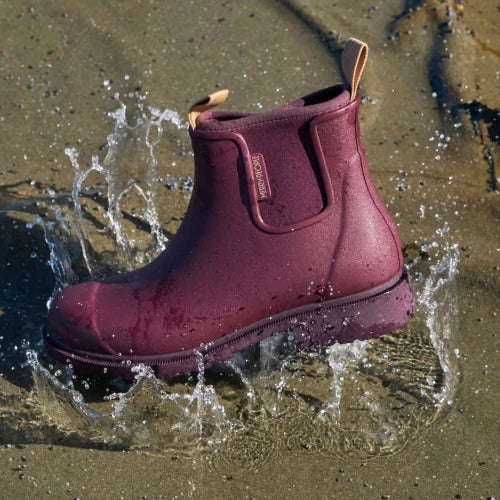The Difference Between Natural Rubber and PVC Rain Boots
If you’ve come to this page, you are probably familiar with what rain boots are and the need for high quality, waterproof boots. But, have you stopped to think, what are rain boots made of? Well, most waterproof boots are made from either natural rubber or polyvinyl chloride - a synthetic material colloquially known as PVC or vinyl.
Natural rubber comes from the latex (sap) of the rubber tree (Havea brasiliensis) which grows globally in tropical biomes such as Brazil, Thailand, and Indonesia. PVC, on the other hand, is a type of plastic formulated in a lab and derived from petroleum. There are pros and cons in working with a nature-based or a synthetic substance as each material offers something different with regards to quality, durability, weight, and affordability.
First, let’s chat about natural rubber! All Merry People gumboots are made with natural rubber outer and sole. To be transformed from latex into rubber (and then into your gumboots), natural latex undergoes vulcanisation, a process developed and patented by Charles Goodyear of Goodyear tyres. Vulcanisation tempers the rubber and allows it to be easily moulded into other shapes. From there, it is die-cast into the curved shapes of boots. This is a longer production process than the methods used in crafting PVC gumboots, but the result is higher quality insulation, softness, and anti-corrosion performance.
The latex of the rubber tree is naturally elastic, soft, and mouldable and it keeps those qualities after vulcanisation. This natural feature is what allows Merry People gumboots to soften, stretch and adapt to your foot with wear. But, as anyone who has used a rubber band knows, this soft elasticity is still quite durable! Once natural rubber undergoes vulcanisation and is cast into a shape it will hold - even at extreme temperatures. This is what allows us to rate our boots for below-freezing temperatures and allows our customers to wear their gumboots in the snow. Finally, as a product derived from nature, rubber is less toxic and damaging to produce and is biodegradable.
The durability, elasticity, and quality of natural rubber does come with trade offs in weight and cost. By its nature, rubber is a heavier material than PVC, meaning natural rubber gumboots are heavier than PVC gumboots. The manual work involved in tapping latex from the rubber tree and processing it into rubber is also more expensive than the processes involved in fabricating PVC. This means that natural rubber gumboots are generally more expensive than PVC gumboots. There is, however, a tradeoff to be made as the higher initial cost for durable natural rubber is paid off in the longevity of the material as your boots will not need to be replaced frequently. We believe strongly in the value behind durability and assessing the cost-per-wear of your gumboots and we stand by this with a one-year warranty on our boots.
Now let’s talk about PVC! PVC is a lightweight synthetic plastic produced, in part, from petroleum. Creating PVC is a complex process involving lots of chemistry, but it is also now a very popular and inexpensive process used across a broad range of industries. To convert PVC into boots, tiny pellets of PVC are melted into a liquid form, then poured around a boot mould in a process called injection-moulding. Injection moulding is used for an array of projects, making it a relatively inexpensive process for fabrication and makes PVC boots a popular low-cost option for waterproofing and for those looking for light-weight boots.
The affordability and lightness of PVC does, however, come with trade-offs. Notably, PVC lacks the stretch of natural rubber and will not stretch to shape your foot. This stiffness can lead to harsh edges on your rain boots and the common complaint that rain boots are uncomfortable. This also means that if your foot is not the standard width of a boot mould, you may find it difficult to fit your foot in the boot. PVC is also less durable than rubber, so while it may be cheaper to purchase initially, they often do not last as long as natural rubber boots. This increases the cost-per-wear value as the boots may need to be replaced or repaired more frequently than natural rubber boots. Some manufacturers work around this by mixing in natural rubber with the PVC to create a hybrid shoe. This combo can keep the cost down, but still lacks the durability and longevity of using 100% natural rubber.
With so many different words used at all stages of production and marketing, “rubber” has become an umbrella term for any plastic material that has a rubber-like feel (e.g., bouncy, elastic) so it is important to double-check the component of your boots! Each material has its own pros and cons, so there is no “right” answer to what material is best for your needs. But if you are looking for a durable, long-lasting, high-quality natural rubber for your waterproof boots, then be sure to check out our Bobbi rain boots! With over 1,500 5-star reviews, they are sure to carry you through all your daily adventures!
Stay Merry everyone!! xx












